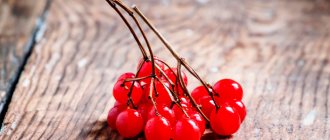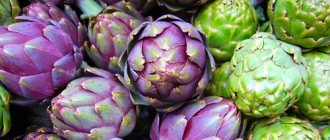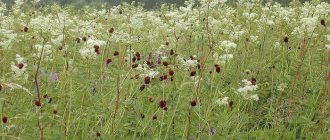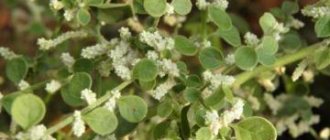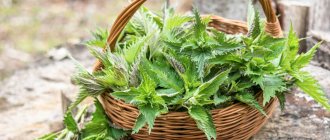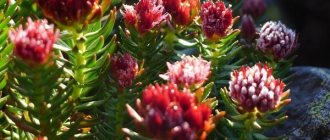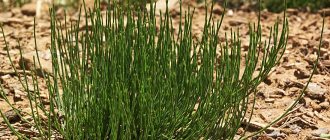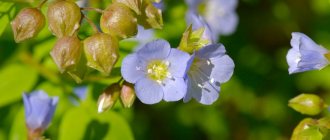Despite the fact that aspen is very famous in temperate climates, people often confuse it with other trees, most often with poplar. Knowing the differences between aspen, it is not very easy to recognize it among other trees, especially for novice gardeners.
In addition, aspen is incredibly resilient; eradicating an uninvited guest from a garden plot becomes a real problem.
Aspen is the closest relative of poplar. Translated from Latin into Russian, aspen means “trembling poplar.” And indeed, when the wind blows, the entire aspen tree begins to tremble from top to bottom.
How does this happen? This question, as well as the question of how to find aspen among other poplar trees, will be answered below.
What does aspen look like and where does it grow?
Aspen (also called trembling poplar) is a wild growing tree of medium height, which can reach 35 m. The diameter of the trunk in rare cases reaches 1 m, although usually this figure is much smaller. Aspen has many varieties, but in folk medicine they traditionally use Common aspen , which can be found everywhere in mid-latitudes.
The edges of the leaves, which have a rounded shape, are cut with large teeth. Their petioles are long, but flattened in the middle, so with every blow of wind the foliage begins to tremble, which is a characteristic feature of the tree. Trembling poplar is a dioecious plant. In males, earrings have a pink or reddish tint, while in females they are green.
Aspen grows quite quickly : after 50 years, its trunk rises 20 meters above the ground. But its lifespan is also short-lived: the life of a tree usually ends after 90 years. It is very rare to find specimens whose age is 130 years.
This tree is found in latitudes with temperate and cold climates throughout the entire European and Asian continent. Aspen often forms entire species tracts, either preferring edges or sunny glades of dense forests.
Characteristics of trees of the aspen genus
The average life of a tree is about 100 years, during which time it manages to grow up to 30-40 meters. The wood has a whitish tint, and at the site of the log house it even gives off a blue tint (there is a version that it was because of this blue color that aspen got its name).
- The tree is considered a fast-growing tree; at the beginning of its life it can grow 40-80 cm every year.
- Aspen is highly valued by woodworkers because it is a soft wood that is quite easy to work with and cut.
Another advantage is aspen’s resistance to moisture. Wood can be preserved in water for a long time, and when dried it does not crack.
Moreover, when wet, it becomes even more amenable to processing and carving; this can be done even with a well-sharpened knife.
Composition and medicinal properties of aspen
The properties of common aspen are explained by its chemical composition, which contains a number of useful substances. The most valuable of them is salicyl, which is a natural analogue of aspirin. Once in the human body, this organic compound relieves inflammation and lowers the increased body temperature caused by it. The highest concentration of salicyl is in the bark of the tree, so it is widely used in alternative medicine.
Aspen also contains:
- vitamins;
- bitterness;
- tannins;
- a number of glycosides;
- complex fatty acids and other acids;
- micro- and macroelements.
- carbohydrates;
- ethers, etc.
Identify by flowers
Yes, yes, don’t be surprised, both the birch and aspen are blooming.
Only the flowers are not ordinary.
Earrings are birch flowers. They appear during the fruiting period. They consist of scales fused in the center, 2-4 cm long. In early spring they are green, and with the arrival of warmth they turn brown.
Aspen also has flowers. They are collected in earrings. A characteristic fluff is visible between the seeds. They are red and up to 15 cm long.
And green ones - they are thinner and shorter.
By fruit
Trees can also be distinguished by their fruits.
Aspen has elongated boxes consisting of 2 or 4 leaves. Inside there are many small seeds with a puff. Aspen blooms in late May early June.
The birch fruit resembles a nut with thin wings. The fruits are very light and small. 5000 nuts weigh 1 gram. They are easily carried by the wind.
What aspen looks like (video)
Therefore, remedies prepared from leaves and especially tree bark help in treating diseases. They provide:
- antipyretic effect;
- anti-inflammatory;
- blood thinner;
- stabilizing the functioning of the endocrine system;
Also, taking aspen increases sweating.
Therefore, the tree is used in the treatment of a number of diseases, primarily associated with inflammatory processes. Also, aspen bark is an ingredient for a folk remedy for treating diabetes.
Advice
In addition to medication and alternative treatment, you should strictly follow a diet and change your lifestyle.
A folk remedy will eliminate unpleasant symptoms, proper drug treatment will relieve hemorrhoids, but if the factors that caused the disease are not removed, it will return.
You should drink more water, eat foods containing fiber, move and be in the fresh air, and then the risk of re-inflammation of the nodes will decrease.
Photo gallery
Wood processing
Being a fairly common and accessible natural raw material, aspen lends itself well to various types of mechanical processing: sawing, cutting, peeling, planing, etc. The largest percentage of material entering processing falls on plywood-match, pulp and paper, container production and sawmilling.
Since aspen wood survives peeling and planing operations well, it is successfully used for the manufacture of plywood and matches. At the same time, it is especially highly valued in match production.
Due to the absence of resinous and aromatic secretions, aspen wood is suitable for the production of barrels and boxes. Also, this material, which has a natural white color and a sufficient length of fibers, is used for the manufacture of paper and cardboard, fiberboard, particle boards, etc.
In addition, after appropriate processing, aspen wood can serve as a raw material for hydrolysis-yeast production, the production of a petroleum fuel substitute and other purposes.
The video shows the processing of aspen waste from a match factory on a granulation line:
Preparation of medicinal raw materials
Crushed aspen bark, ready for preparation, is sold in pharmacies and herbal shops. But, having gone to the forest, you can collect and produce plant materials yourself: no special skills or knowledge are required for this.
The leaves of the tree are collected in May or June. After this, they need to be dried in a special dryer at a temperature of about 55 ° C or spread on paper in a dry, warm and well-ventilated room. You can also use the heat of a stove oven preheated to 60°. In a similar way, the buds of trembling poplar are harvested in early spring.
It is a little more difficult to collect aspen bark. To do this, you will need a sharp knife to make the job easier. You need to go to the forest from approximately April 20 to June 1, because during this period there is an active movement of sap. You need to choose young trees whose trunk diameter is no more than 8 cm. Using a knife, make two round cuts around the tree at a distance of 30 cm from each other. Then the bark is cut vertically between them and carefully removed. You need to make sure that there are no pieces of wood left on it. The same manipulations can be repeated with branches.
When you get home, you should wash the bark and dry it in the oven, cutting it into small pieces of 3–4 cm. The temperature should not exceed 60 °C. Drying can also be done in a dry, ventilated area, but in this case the process will take up to a week.
It is forbidden to dry the leaves and bark in direct sunlight. This way, most of the useful things will evaporate from the healing raw materials. Harvested aspen can be stored for up to 3 years, although it is considered most useful in the first year after harvest.
Climatic conditions
In order for aspen to feel good, climatic conditions must be met. You can find aspen in mixed deciduous forests. However, there are often isolated forest plantations consisting only of aspen trees. The tree usually grows in open areas. If a massive tree is located nearby, the aspen dies.
Pines and spruces often appear among the aspens. In the first years, aspen acts as a kind of cover for conifers. But gradually, when the trees become taller than the aspen, they shade it, and the tree loses its external characteristics and dies.
The use of aspen in folk medicine
Mostly in folk medicine, aspen bark is used, which is most valuable due to its composition. Products are made from it in a variety of forms: decoctions, infusions, alcohol tinctures and even ointments.
Decoctions and infusions from aspen
There are 3 main ways to make a decoction and infusion of aspen bark:
- Finely crushed bark is poured with clean water in a ratio of 1:4 . Place the container on low heat, wait until it boils and leave for another 30 minutes. After this time, the broth should sit for at least 6 more hours, tightly closed with a lid. This “greenhouse effect” will help the beneficial substances to be released into the water. If the bark was purchased at a pharmacy, then the boiling time is reduced to 5 minutes, since the raw material has already undergone heat treatment. This remedy is taken half a glass three times a day 30 minutes before meals. The decoction is especially useful for diabetes.
- An infusion of aspen bark is very useful for pulmonary tuberculosis and inflammatory diseases . To prepare it, 1 tbsp. a spoonful of raw material is poured into 0.5 liters of hot water and left for 12 hours. Drink a glass in the morning and evening.
- Otherwise, an infusion is prepared for the treatment of diabetes: the bark and boiling water are combined in a ratio of 1:3 and left for 10–12 hours. It is preferable to take the product in the morning on an empty stomach. Between courses of treatment, each of which lasts 3 weeks, there should be a 10-day break.
The most useful are decoctions and infusions immediately after preparation. Over time, the beneficial substances disappear from them. Although the liquid may have an unpleasant aftertaste, it is not recommended to sweeten it, even with sugar substitutes.
Aspen ointment
The ointment will help with areas of inflammation on the skin, burns and dermatitis. The bark should be burned, and the resulting ash (10 g) mixed with Vaseline (20 g). This remedy can be stored in the refrigerator and used if necessary until recovery. Very soon the unpleasant symptoms will disappear.
Tincture of aspen with vodka
A universal tincture of aspen with vodka suppresses inflammatory processes in the body, enhances the functioning of the immune system and improves health thanks to vitamins and minerals. To prepare it, you need to mix the bark and vodka: for 100 g of raw materials you will need 200 ml.
The bottle is placed in a dark place for 2 weeks. After this, you need to strain the liquid and consume 15–20 drops before meals. To make it easier to drink the tincture, it is diluted in a third of a glass of still mineral water.
How to brew aspen bark
Tea made from aspen bark is recommended for diabetics, people during the recovery period after infectious diseases, and also for prevention when there is a tendency to increase blood sugar levels. It is enough to pour a couple of glasses of boiling water over the bark (2 tablespoons) and leave it in a teapot or thermos for 30–60 minutes. Drink immediately after preparation.
Kvass from aspen for the treatment of diabetes
Aspen kvass is not only good for health and lowers sugar, but also pleasant on hot days because it is very refreshing. To prepare it, you will need a 3 liter jar. It is filled with either dry bark (a third of the container) or fresh bark (half a jar). Also add 2/3 cup granulated sugar, water and 1 teaspoon of fat sour cream. In a couple of weeks, the unusual and healing drink will be ready.
Interesting facts about the tree
Aspen is used not only in medicine; it is necessary to note some facts:
- Aspen bark is a favorite delicacy of deer, elk and hares, so if the tree is grown at home, it is necessary to protect the trunk from unexpected guests.
- In the old days, when fermenting cabbage, several aspen branches were placed in a container. This additive improves the taste and eliminates harmful microbes that appear during cabbage fermentation.
- Wood is used for processing log houses in wells, since the material does not decompose or rot.
- Artificial vanillin was made from rotten wood.
- Due to its antibacterial and hemostatic properties, antipyretics were previously made from aspen material.
- Ash from aspen was used as an organic fertilizer because, unlike other types of wood, it contains a large list of useful substances.
Aspen is a tree that is distinguished by its external characteristics. To compare varieties, it is necessary to study not only the photo and description, but also the natural appearance of the plant.
Wood is valued not only for its appearance. The bark and leaves of the crop have medicinal properties; an equally valuable factor is the wood, which is used in construction. Therefore, the crop is often planted in plots to decorate and improve the quality of the soil.
Who should not be treated with aspen
Taking folk remedies from aspen has virtually no contraindications, except:
- individual intolerance and allergies;
- dysbacteriosis;
- diseases of the gastrointestinal tract in acute form;
- tendency to constipation because tannins produce an astringent effect.
When starting treatment with aspen, you must first try the remedy in a small dosage and observe the body’s reaction.
Compresses
- The very first and simplest way is to apply leaves to hemorrhoidal cones. You need to thoroughly wash a few leaves and apply them for a couple of hours, then remove them. After an hour, you need to apply new leaves, then wash with cool water. You need to repeat the procedure every other day, 3 times a week. The course of treatment is only 7 days. In this short time, the symptoms of hemorrhoids should go away.
- Aspen leaves should be finely chopped. You can cut it with a knife, then grind it, you can put everything in a blender, the main thing is that it turns out something like a paste. You need to lie on your stomach, spread the resulting mixture on gauze and apply it to the anus for a couple of hours. After the specified time, rinse everything off with cool water and anoint the anus with baby Vaseline. It is recommended to lie down for another hour after the procedure. If during the procedure you feel discomfort in the anus, you should wash everything off immediately. The manipulation should be repeated every two days, gradually reducing the amount of ointment. Treatment should be stopped after the disappearance of hemorrhoids.
